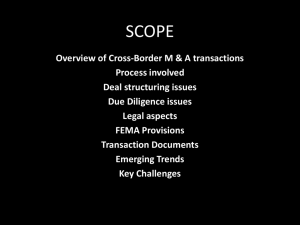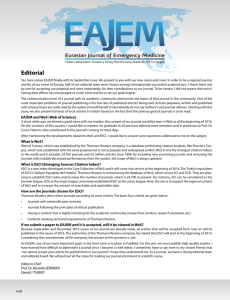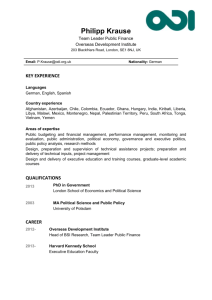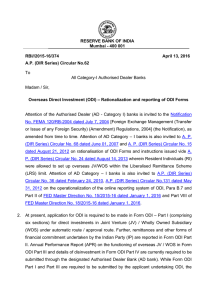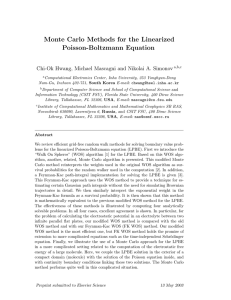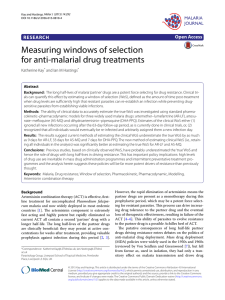Cross-Border Mergers and Acquisitions
advertisement
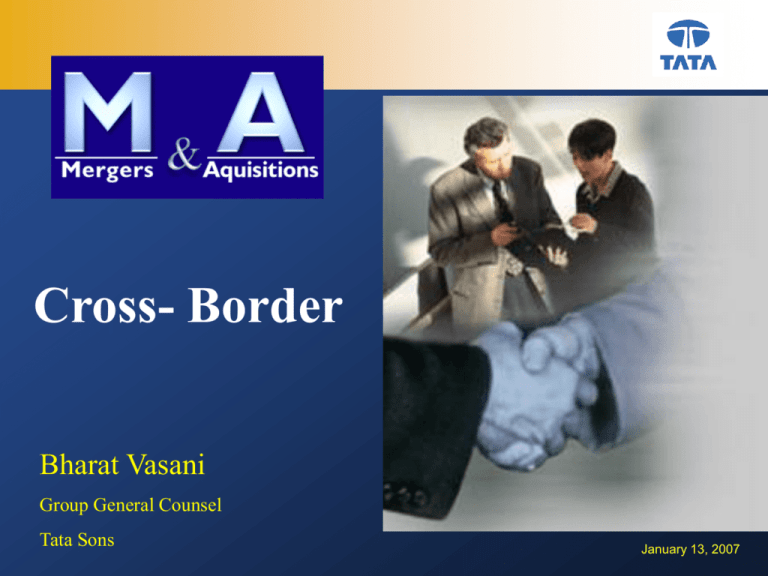
Cross- Border Bharat Vasani Group General Counsel Tata Sons January 13, 2007 Scope of the Presentation Overview of Cross-Border M & A transactions Process involved Deal structuring issues Due Diligence issues Legal aspects FEMA Provisions Transaction Documents Emerging Trends Key Challenges January 13, 2007 Objectives Greater Economies of Scale Access to Raw Material Access to Markets Diversification of Business January 13, 2007 Cross Border Transaction Imperatives Business Environment Cultural Issues Business Dynamics Accounting treatment Legal & regulatory framework Tax regimes & treaties Identifying and delivering synergies January 13, 2007 Key Tax And Considerations 2 1 Financial Entry Strategy 3 Financing options Income flows and their taxability 4 6 Exit considerations Debt Structuring Cash repatriation January 13, 2007 Categories Of Cross Border Acquisitions Corporate Partnering Public to Private Supporting Management Buy Outs Leveraged Buy Outs Strategic Investments Earn Out Acquisitions Distress Sale January 13, 2007 Applicable Laws India Companies Act – Section 372A, FEMA Regulations Tax Target jurisdiction Company Law & Competition law Exchange Control Regulations Takeover Regulations Tax January 13, 2007 Process Assemble Team Limited Due Diligence Purchaser obtains financing commitment MoU / LoI Detailed due diligence Definitive Purchase Agreement Purchaser’s firm financing Seller and Purchaser comply with covenants CLOSING January 13, 2007 Structuring Issues Tax Financing Corporate Veil Regulatory constraints (host & target countries) Exchange Control Regulations January 13, 2007 First Steps Appointment of Advisor Investment Banker Attorneys (Local and Offshore) Public Relations Agents Identify Due Diligence Areas To achieve commercial objectives Acquisition Strategic Investment Preliminary Documentation Review of Information Memorandum Entering into mandate letter with Advisors Executive Non-Disclosure Agreement Exclusivity Arrangements January 13, 2007 LoIs / MoUs Pros Binding v/s. Non-binding Reduces basic understanding to writing It may look different in written form From buyers perspective Cons Exclusivity may cut-off seller’s negotiations with third party Provides basis for expense reimbursement Leaks Duty to disclose Contents January 13, 2007 Due Diligence Methodology: Physical Data Room Virtual Data Room DD list needs to be carefully tailored to meet the needs of specific transaction and jurisdiction Specific inputs needed from local lawyers and tax advisors January 13, 2007 Due Diligence Effective Due Diligence Process should address the following Strategy Assumptions Identify operational, legal, financial and other significant issues Assessment of Risks Effect of assessment on Valuation (e.g. Fair Price for the Target Company) January 13, 2007 Illustrative Due Diligence issues (1) Onerous obligations/covenants Payment of ongoing fee/royalty Restriction on activities Rights of first refusal/put/call option LDs/ penal provisions/any liability which flows through January 13, 2007 Illustrative Due Diligence issues (2) Exclusivity provisions Confidentiality Assignability / change of control/ consent of the counter party for transactions Regulatory Approvals January 13, 2007 Impact of Due Diligence Impact on M&A Agreements Representations, warranties, indemnities, covenants Conditions precedent, conditions subsequent Holdback / escrow (mechanism for retention) of purchase price, bank guarantee, milestones for payment Functions as an internal audit for post acquisition strategy In cross-border deals - Impact of applicable law to Transaction (Competition Law issues, Dominant Undertaking, Takeover Regulations, Insider Trading, etc.) January 13, 2007 Results of Due Diligence What can the purchaser do? Require the seller to remedy the problem Obtain an indemnity/other contractual protection Restructure deal to exclude asset or liability Reduce purchase price Insurance in respect of risk – “price” – the risk Pull out Limitations of liability Cap on liability Threshold – “basket” De-minimis Others What should limitations apply to? Allocation of Risks Representations and Warranties Who gives? All shareholders Institutional shareholders Involvement of management Extent Creditworthiness of person giving warranties – consider guarantee January 13, 2007 Cross Border Deals - Agreements Stock Purchase/ Subscription Agreement Technology Collaboration Agreement Product Supply Agreement Employment Agreement Shareholders’ Agreement Brand Licensing Agreement Loan/ Security Agreement Feeder Stocks Supply Agreement Exclusivity Arrangement Code of Ethics Information Memorandum Labour Union Settlement January 13, 2007 Typical Regulatory Approvals Competition Authority Stock Exchange Board of Target Company Lenders Foreign Investment Authority Sector Regulators January 13, 2007 Issues under Companies Act Section 372A – Inter corporate loans & investment beyond 60% of paid up capital and free reserves or 100% of reserves to be approved by shareholders Complications in International bidding due to disclosure requirements January 13, 2007 ODI - Issues under FEMA (1) Overseas Direct Investment (‘ODI’) Permissible in: • overseas Joint Venture (‘JV’); or • overseas Wholly Owned Subsidiary (‘WoS’) ODI not permitted in real estate business or banking business Conditions for investment under the automatic route Total permissible financial commitment ≤ 200% of the net worth Bona fide business activities January 13, 2007 ODI- Issues under FEMA (2) Eligibility norms for Investor: not on RBI’s exporters’ caution list / list of defaulters not under investigation by investigation / enforcement agency or regulatory body Filings in respect of ODI (in Form APR) to be up-todate All transactions with the JV/WoS to be routed through 1 AD branch Form ODA (with details of ODI under automatic route) to be submitted to the AD Total Permissible Financial Commitment (post August 12, 2005) ECBs – different views January 13, 2007 ODI- Issues under FEMA (3) Cash remittance by market purchase Capitalization of: export proceeds, and fees, royalties, commissions or other entitlements due from foreign entity for supply of technical know-how, consultancy, managerial or other services 50% of the value of guarantees issued to or on behalf of the JV / WoS Direct and indirect investment in agricultural operations January 13, 2007 Financing an Acquisition Funding Methods Drawal of foreign exchange from AD Swap of ADRs/GDRs Utilization of proceeds of ECBs / FCCBs Balances in EEFC account Utilization of foreign currency funds raised through ADR / GDR issues 200% net worth ceiling not applicable in case of funding by: Balances in EEFC account Utilization of foreign currency funds raised through ADR / GDR issues January 13, 2007 Valuation of Shares Investment more than USD 5 MN: By a Category 1 Merchant Banker registered with SEBI; or By an Investment Banker / Merchant Banker registered with the appropriate regulatory authority in the host country Investment less than USD 5 MN: By a Chartered Accountant or a Certified Public Accountant Where consideration is fully / partly paid by issue of Indian Party’s shares: By a Category 1 Merchant Banker registered SEBI; or By an Investment Banker / Merchant Banker registered with the appropriate regulatory authority in the host country. January 13, 2007 Post Investment Changes Step Down Subsidiary JV / WoS Post investment changes / additional investment in existing JV / WoS Step Down Sub (1) Step Down Sub (2) Step Down Sub (3) Parent Co Post investment changes / additional investment in existing JV / WoS JV/WoS may diversify its activities Set-up step down subsidiaries Alter shareholding pattern in the overseas entity Reportings to be made to the RBI in Form APR January 13, 2007 Acquisition in Financial Services Sector (1) (Additional) Conditions for Investment in Financial Services Sector under automatic route Net profit earned during last 3 years from financial services activities Registration with appropriate authority for conducting financial services activities Approval from concerned regulatory authorities, both in India and abroad, for venturing into such financial service activity Fulfillment of prudential norms relating to capital adequacy Above applicable to JV/ WoS or its step down subsidiary for making additional investment in the Financial Services Sector January 13, 2007 Acquisition Sector (2) in Financial Services Recent Development: Compliance with above conditions by regulated Indian entities engaged in financial services for investing overseas in any activity Trading in commodities exchanges to be reckoned as a financial service and require prior approval of the Forward Markets Commission January 13, 2007 Certain other FEMA Issues (1) Earnest Money Deposit Or Issue A Bid Bond Guarantee Remittance of earnest money deposit or issue a bid bond guarantee permitted for acquisition of a foreign company through bidding and tender procedure Subsequent remittances through AD also permitted Pledge of Shares / Hedging Indian Party may pledge shares of JV/WoS to AD / financial institution for credit facility for itself or JV/WoS abroad Indian Parties with ODI permitted to hedge the exchange risk arising on such investments January 13, 2007 Certain other FEMA Issues (2) Sale of Shares Listed – through stock exchange Unlisted – price not less than fair value certified by CA No outstanding dues (dividend, technical know-how, royalty, consultancy etc) No write-off except in certain specified circumstances Overseas entity in operation for at least 1 year and proper filings in Form APR Indian party not under investigation by CBI / ED / SEBI / IRDA or other Indian regulatory authorities January 13, 2007 Certain other FEMA Issues (3) Annual Performance Reports (APR) Indian party to submit APR to RBI (in Form APR) in respect of ODI Time period: within 60 days of prescribed date for finalization of the audited accounts of overseas company Detailed report containing various disclosures including details of the “line of activity”, financial structure and performance of the overseas company January 13, 2007 Leveraged Buy- Outs (1) Borrowing without Recourse Target Co Borrowing Dividend SPV Lender WoS (2) WoS (1) Offshor e Onshore Parent Co January 13, 2007 Leveraged Buy- Outs (2) Background Limitation on Indian Parent Co for making overseas investments upto 200% of its net worth under the “automatic route” Borrowing without recourse, an option to overcome this limitation Salient features Indian Parent Co sets up a wholly owned indirect subsidiary: Bid Co Bid Co borrows money from lenders and utilizes that money to acquire the Target Loan secured by the dividend stream of the Target Shares of the Bid Co and the Target are usually pledged in favour of the lenders “No recourse” or “financial commitment” on Parent Co January 13, 2007 Leveraged Buy- Outs (3) Advantages No recourse on Parent Co Not counted towards 200% cap Parent Co’s balance sheet clean for further investments Parent can raise further money for investment Disadvantages Costly form of borrowing Stringent conditions on up streaming of dividends and “cash sweeps” by Parent Co Works best if target is de-listed, otherwise dividend leakage January 13, 2007 Certain Grey Areas Round Tripping JV / WoS (1) JV / WoS (2) Offshor e Onshore Investor Co Target Co Condition for outbound investment: Bona fide business activity (offshore) “Round Tripping”: Money from India is being routed back into India from another jurisdiction. Concept not enshrined in any rule or regulation issued by RBI. Round tripping; if identified – investments could be ordered to be January 13, 2007 unwound. Share Purchase Agreement Key issues Reps and Warranties based on due diligence reports Conditions Precedent & Subsequent Closing mechanism Indemnity from seller Statutory approvals – CPs to closing Hold back, brand usage and non-compete Competition law issues January 13, 2007 Purpose of Representations Disclosure Termination Rights Indemnification Disclosure Termination Rights Signing Indemnification Closing January 13, 2007 Indemnification Issues (1) Buyer’s knowledge of Seller’s breach Protection beyond Representations and Warranties Joint and several liability Creditworthiness of the Seller Offset for tax or insurance benefits Interest on damages Separate environmental and tax indemnification January 13, 2007 Indemnification Issues (2) Time limitations Basket Minimum Cap Escrow Control of litigation Representation and Warranty Insurance January 13, 2007 Governing Law & Dispute Resolution Choice of Law Domestic/Neutral Mediation Informal Institutional Mechanism: Courts v. Arbitration Domestic/Neutral Costs Interim relief Appeal rights Enforcement January 13, 2007 Emerging Trends Aggressive Indian presence in Global M & A market High level of sophistication in structuring of deals Competing bids in high value transactions Deal Protection Mechanism (Break fees etc.) Insurance of Reps and Warranties Virtual Data Rooms Use of Media and PR agencies Steep increase in parachute payments Steep increase in transaction costs January 13, 2007 Key Challenges Operational issues post merger / acquisition Integration of the cultures of the organizations Realisation of synergies Alignment of HR policies and practices Optimum utilization of manpower Optimum utilization of other infrastructural resources January 13, 2007 Any Questions January 13, 2007 Thank You bvasani@tata.com 44
